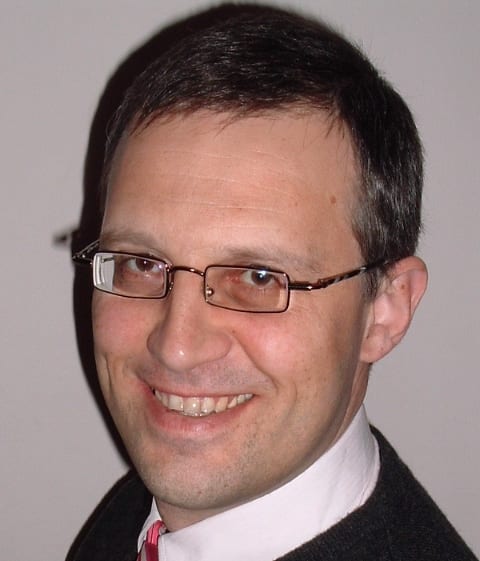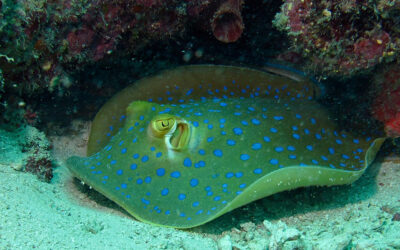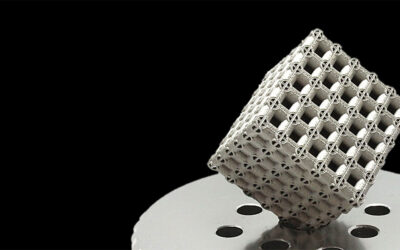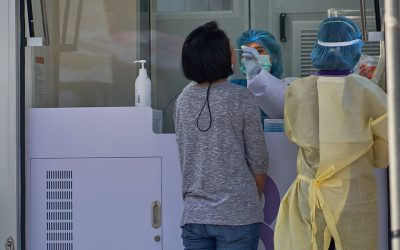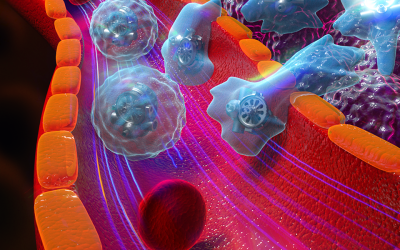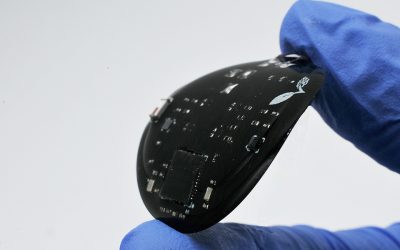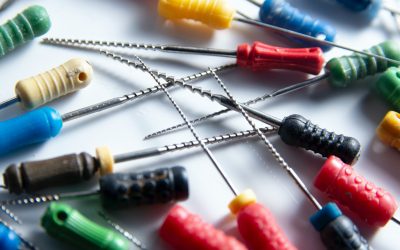
Andrey L. Rogach is a Professor at the Department of Physics and Materials Science, City University of Hong Kong.
In the latest of our series of interviews with top materials scientists, we speak to Professor Andrey Rogach, 8th most cited author on nanocrystals worldwide (according to the ESI) and co-author of Properties and Applications of Colloidal Nonspherical Noble Metal Nanoparticles and Nonspherical Noble Metal Nanoparticles: Colloid-Chemical Synthesis and Morphology Control, two of the most downloaded recent articles from Advanced Materials.
What attracted you to science, and how did you get to where you are now?
I grew up in Minsk, the capital city of what was called in those times the BSSR – Belarusian Soviet Socialist Republic – in a family of scientists. Both of my parents held PhD degrees in chemistry and worked at the University and at the Academy of Sciences of Belarus. When I was a child, I was mainly curious about two things: archeology and foreign countries. At some point, archeology dropped down, while the interest in foreign countries persisted, bringing me to where I am now: after spending 14 years in Germany (7 years in Hamburg and 7 years in Munich, two German cities locals say cannot be any more different) I find myself now a professor in Hong Kong. Having both parents active in academia, it was very natural for me to decide very early that I would like to follow their path. Taking chemistry as a subject was again quite natural for me. Our home was full of chemistry and materials science books ranging from popular to advanced; I read a lot as a child (probably too much, as my parents often said) and I very early got an idea about the major concepts in chemistry and materials science. I entered the top-tier Belarusian State University in 1986, the year when the Soviet Union started to change, and graduated in 1991, the year of its collapse. We had great teachers there, and I am proud to realize again and again how successful and well recognized over the world many of my fellow students of those days became.
The years of my PhD (1991-1995) were pretty wild in Belarus, as in all other post-Soviet countries. Everything was changing, new opportunities opened up, and I jumped on one of them given by what is called the DAAD – the German Academic Exchange Service. This foundation just started to offer fellowships in Belarus for spending a postdoctoral year in Germany – something entirely new for that part of the world in those times. DAAD had two major requirements for applicants to be successful – knowledge of the German language and an offer from a host professor in Germany. I mastered the basics of the German language in 3 months, and I was very fortunate to secure an offer from Horst Weller, one of the pioneers in semiconductor nanocrystals, to join his very recently established group at the University of Hamburg. The topic of my PhD was actually related to silver nanoparticles – when I started studying them as a third-year undergraduate student in 1989, we did not yet call them nanocrystals, but rather clusters or ultra-fine particles. The great opportunities of what is now called nanoscience and nanotechnology have fascinated me very much, and the change of research focus from metal nanoparticles to semiconductor nanocrystals related to my move to Hamburg in 1995 offered a welcome opportunity to broaden and deepen my scientific expertise.
After a short stay back in Minsk in 1996, I returned to Hamburg, where I then worked till 2002 with several breaks for collaborative projects in the UK (by British Telecom Labs) and the USA (with Nicholas Kotov). In 2002-2009, I held a permanent position in the Photonics and Optoelectronics Group at the Physics Department of the Ludwig-Maximilians-Universität (LMU) in Munich, which is led by the great scientist Jochen Feldmann. In a very productive environment of my colleague-physicists in Munich, I extended my research interests to photoluminescence spectroscopy of semiconductor nanocrystals and their hybrid structures. In particular, Förster resonance energy transfer with nanocrystals and the charge separation aspects in hybrid nanocrystal-based composite materials have been addressed in detail. In 2009, I completed my Habilitation in experimental physics on “Light emission and harvesting with semiconductor nanocrystals: Synthesis, spectroscopy and applications“ at LMU, and moved to Hong Kong accepting an offer for a professorship position from the Department of Physics and Materials Science of City University. One great privilege which scientists do enjoy is the great flexibility to shape their scientific career – and I am pretty curious to see where I may arrive in, let’s say, seven years from that move (remember my 7 years in Hamburg and 7 years in Munich).
What are some of the challenges of being in Asia after spending most of your career in Europe?
I am asked this question pretty often – there are not too many challenges but rather opportunities for me to be in this very dynamic part of the world. In fact, Hong Kong is not just Asian but also pretty Western, very international and fascinating place, and City University of Hong Kong, with its Materials Science being one of the strongest in Asia, offers me both a great research environment and funding opportunities. I always loved to do collaborative research, and I am now busy expanding my contacts to neighboring Asian countries, in particular Mainland China, Japan, India and Vietnam. At the same time, I keep my roots and connections to Europe: I am very fortunate to use them now to build up my very international group in Hong Kong. Our move to Hong Kong appears to be pretty beneficial for our children: they experienced a new culture, mastered English and are now busy learning Chinese.
Much of your research is related to CdTe nanocrystals. What makes them so attractive to study?
It was during my postdoc year at the University of Hamburg that I pioneered an aqueous synthesis of thiol-capped, water-soluble CdTe nanocrystals with size-dependent emission in the visible spectral range (Rogach et al., “Synthesis and characterization of thiol-stabilized CdTe nanocrystals,” Ber. Bunsen-Ges. Phys. Chem. 1996, 100, 1772). These nanocrystals have proven themselves as outstanding nanomaterials steadily attracting great interest worldwide. Among the main highlights expressing this success are very simple, yet versatile synthesis; a great variety of surface functionalities offered by easy employment of various thiols as capping agent molecules at the synthetic stage; ease of processability leading to a large variety of composite materials employing thiol-capped nanocrystals as building blocks; and last by not least high photoluminescence quantum yields of as-prepared core-only nanoparticles easily reaching 40-80% in aqueous medium nowadays. All my major publications on thiol-capped CdTe nanocrystals are extremely well cited. The above mentioned very first one is at the moment the 9th most cited paper of Ber. Bunsen-Ges. Phys. Chem., a very traditional German journal which was published from 1894 to 1999, the fact of which I am especially proud. The feature article by Rogach et al “Aqueous synthesis of thiol-capped CdTe nanocrystals: state-of-the-art” published in 2007 is the 2nd most cited paper of J. Phys. Chem. C. Our very recent perspective article in Phys. Chem. Chem. Phys. 2010 by Gaponik and Rogach provides the most up-to-date summary of the recent progress, perspectives and applications of the related research fields.
What do you think is the biggest challenge that scientists currently face?
One of the biggest challenges facing the scientific community nowadays is to master a move to renewable energies, and my current research on semiconductor nanocrystals has several related facets. Light harvesting, in terms of the efficient collection of sunlight, is a topic of global significance, especially due to the limited resources of fuels, air pollution and global warming. Nanoscience and nanotechnology can provide valuable solutions for an effective design of photovoltaic devices, reducing their cost and increasing efficiency. Semiconductor nanocrystals are very efficient absorbers of light, whose morphology, electronic structure and optical properties can be controlled with an exceptionally high degree at the synthetic stage. They are at the same time ideal building blocks to explore hybrid materials and functional devices, where the function can be build-in at the synthetic stage. Nano is the natural dimension for energy-related applications, as both light harvesting, charge separation and transfer processes occur on this length scale. Hybrid nanomaterials not only offer ample potential for efficient photovoltaic devices, but also very naturally enable fundamental studies on the level of elementary processes involving light harvesting and its conversion into electrical or chemical energy. My current research ranges from fundamental studies on light harvesting and charge separation in hybrid nanocrystal-based structures for photovoltaic applications to the development of novel nanomaterials for water splitting and hydrogen generation (cf. a recent paper in Appl. Phys. Lett. 2010, 97, 093108).
What are you currently working on, apart from your day-to-day scientific research?
Having mentioned that silver nanoparticles have been the topic of my PhD, I still feel myself very much attracted to this research field. Among my ~200 publications, with the majority of them on semiconductor nanocrystals, approximately 25 are on metal nanoparticles. In particular, two our recent publications in Advanced Materials, T. K. Sau and A. L. Rogach ”Nonspherical noble metal nanoparticles: Colloid-chemical synthesis and morphology control” and T. K. Sau, A. L. Rogach, F. Jäckel, T. A. Klar and J. Feldmann ”Properties and applications of colloidal nonspherical noble metal nanoparticles” attracted a great interest of scientific community, belonging to the most accessed articles in 2010. The fascinating relationship between the properties of metal nanoparticles and their size, shape, and crystal form is being heavily researched worldwide. Metal nanoparticles with plethora of morphologies have been reported – plates, prisms, rods, wires, cages, dumbbells, stars, rings and tubes to name a few. Despite this, researchers still lack a complete understanding of the general principles that exist behind their shape and architectural control. It is therefore felt that the need of the day is to have a single podium where one could find not only various techniques of preparation and characterization of metal nanoparticles with controlled morphology and architecture, but also the details of the basic principles involved in those techniques, and why, how and where these novel nanomaterials are being used. To address this need, Tapan Sau and myself have been recently invited by Wiley-VCH to edit a book on “Complex-Shaped Metal Nanoparticles”. We are very much looking forward to collaborate with Wiley-VCH on this exciting ambitious project. The book is thought to provide a sound review of existing knowledge from the basics to the recent developments in the field of theory and modeling, synthesis, characterization, properties and various facets of applications of complex-shaped metal nanoparticles, emphasizing the underlying concepts and principles in details.
Where do you see the field of materials science in 10 years time?
Function and applications are two keywords here, in my opinion. I recently had an interesting discussion with Gabor Somorjai of UC Berkeley on this aspect, and our mutual consent was that particularly chemists should look for a function behind materials they synthesize, aggressively pursuing it for a particular application. This is especially true for nanomaterials science, which has now to realize its potential for real-world applications. The above mentioned field of renewable energies offers ample opportunities here. This brings us to yet another important point of interdisciplinarity in science: any major breakthrough is almost for sure bound to appear at the boundaries of different disciplines nowadays. Nanoscience is interdisciplinary per definition, and materials scientists working with nanomaterials should be very open to explore collaborative research. I have been very fortunate during my career in this respect, starting as a chemist/materials scientist and then gradually getting involved in physics and biomedical-related research. When I decided to move to Hong Kong, I particularly liked the fact that the Department which gave me an offer unifies Physics and Materials Science in one unit.
Andrey L. Rogach is a Professor at the Department of Physics and Materials Science, City University of Hong Kong.

